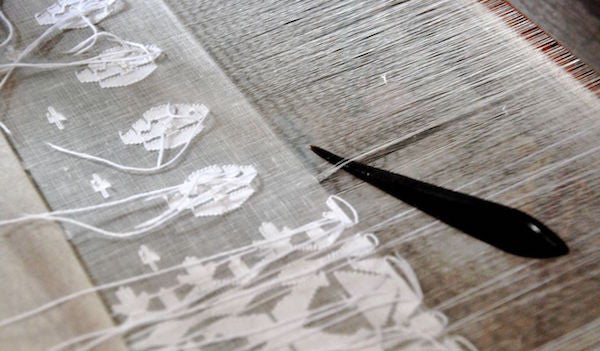
THE JOY OF JAMDANI
In an exclusive excerpt from our current issue of Selvedge, we explore the history of one of the finest muslins to ever be produced in India...
Possibly the finest of all muslins, jamdani combines cobweb delicacy with intricate design to create the most desirable fabric, infinitely breathable in hot humid climates, yet downy soft. The traditional art of jamdani weaving was inscribed on the Representative List of the Intangible Cultural Heritage of Humanity by UNESCO in 2013 in honour of its esteemed history.

The first references to jamdani occur in the 17th century during the time of the Mughal Empire when Emperor Jahangir wore a sash of jamdani woven with floral designs. The jamdani was made of Dhaka muslin of such fine quality that it was said that it was spun from the air, as only the finest gossamer filaments of the cotton were used. Such fragile fibres could only be worked in humid air by the supple fingers of young women who worked surrounded by bowls of water or on moored boats, giving rise to the legend that Dhaka muslin was made by mermaids singing in the mist.

Such exquisite work came at a high price, and according to J Forbes Watson’s The Textile Manufactures and the Costumes of the People of India published in 1867, the manufacture of the finest jamdanis during the British rule of the 19th century was held as a monopoly by the government. Select brokers paid a significant fee to the government for the right to deal in jamdani muslins in both home and international markets, and the sale of any valuable pieces by the weavers was forbidden under the threat of corporal punishment.

Traditionally woven on a handloom, the motifs are woven by the discontinuous weft technique whereby the threads necessary for the design appear only there, and in order to maintain the delicacy of the muslin, are not taken across from selvedge to selvedge. Jamdani muslin is special to Dhaka in Bangladesh where a wide variety of geometric and repeat patterns are woven, as well as the traditional floral and figured designs which are not written down, only woven by the master weavers by eye. Sadly the Dhaka muslin industry was lost during the 1900s and jamdani weaving is all that remains; yet jamdani saris remain the finest and most sought after in the world.
To buy the current issue of Selvedge, click here.

1 comment
I like this sarees . It is very beautiful one . It were I am full satisfaction